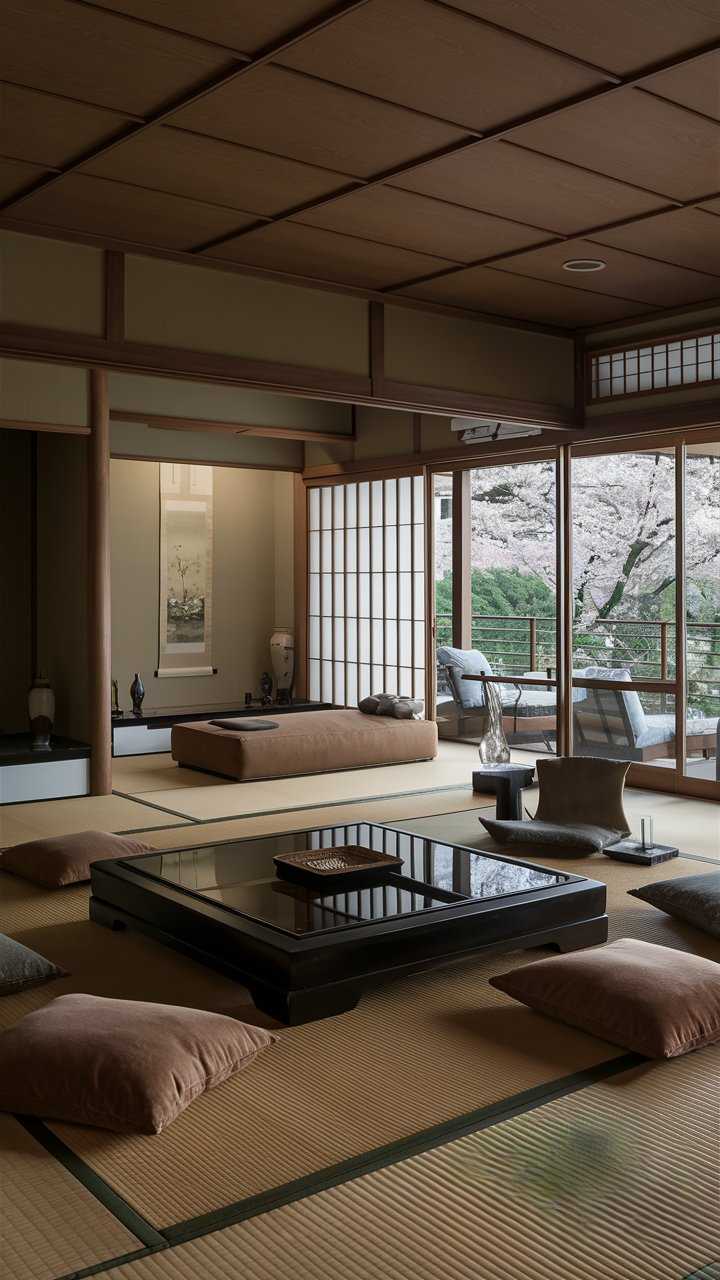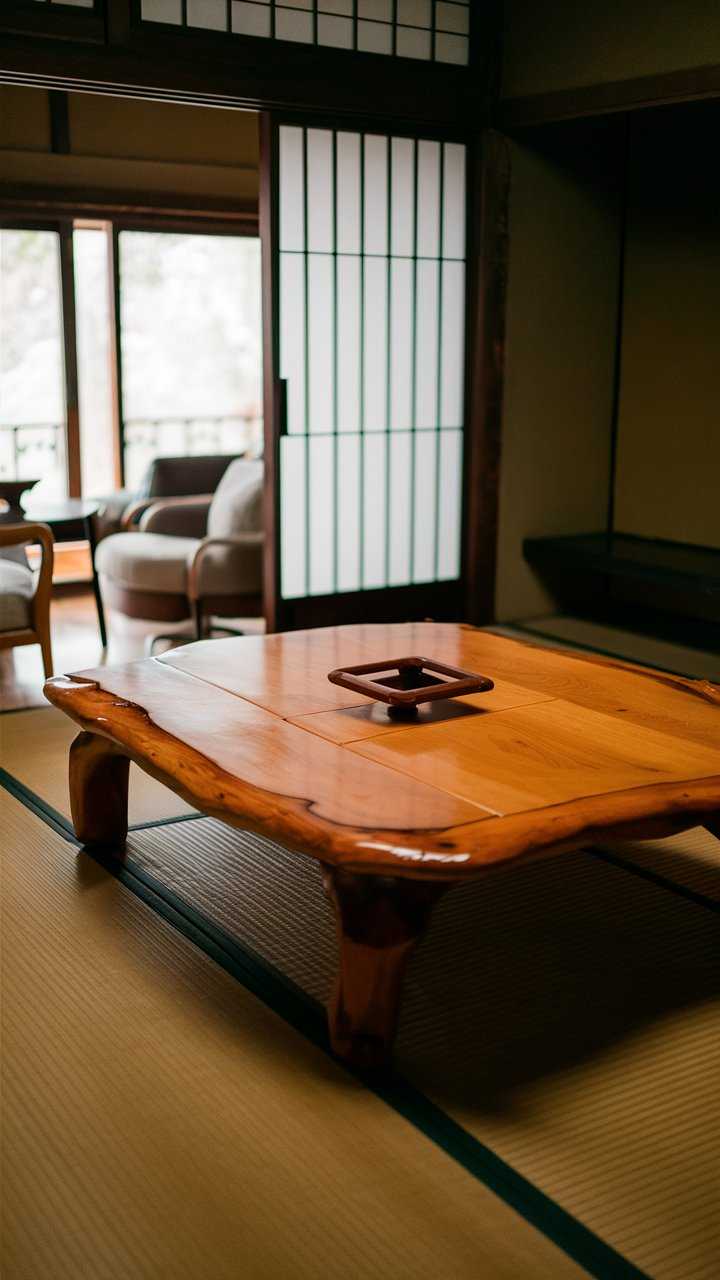Japanese Living Room Design Ideas for Zen-Inspired Homes
Creating a peaceful living space is an art. Japanese interior design shows us how to do it best. This article shares ideas for a living room that feels zen and simple. By mixing simplicity with elegance, you can make your home a calm place for relaxation and mindfulness.
Explore Japanese style to find the elements that will make your living space better.
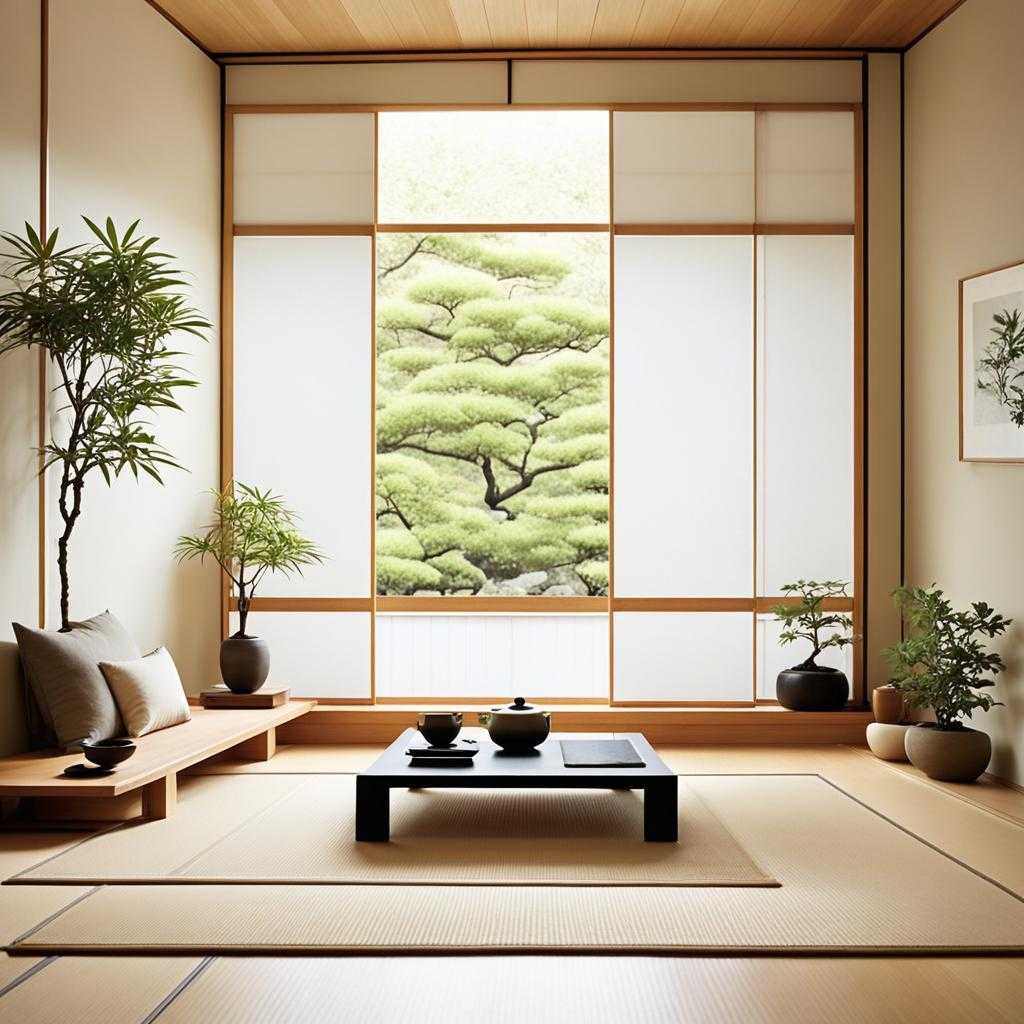
Key Takeaways
- Incorporate minimalist design principles to achieve a tranquil atmosphere.
- Use neutral color palettes to enhance calmness and serenity.
- Integrate natural materials for a deeper connection to nature.
- Consider low-profile furniture for an authentic Japanese aesthetic.
- Bring in indoor plants to create a refreshing environment.
- Utilize soft lighting to establish a calming ambiance.
The Essence of Japanese Interior Design
Japanese interior design is all about simplicity, beauty, and functionality. It takes cues from traditional Japanese interiors. The focus is on a minimalist aesthetic that makes spaces calm.
Wabi-sabi, a philosophy, is at the heart of this design. It values imperfection and the ever-changing nature of life. This leads to spaces with clean lines and no clutter.
Timeless Elegance and Minimalism
Japanese interior design is known for its timeless elegance. It uses classic furniture and decor that are both beautiful and practical. This makes spaces peaceful retreats.
Every item is chosen to add to the calmness of the room. People love the serene beauty of these spaces. Each piece adds to a feeling of balance.
Connection to Nature
Using natural materials is key to feeling connected to nature. Wood, bamboo, and stone are often used to bring the outdoors in. This shows the deep connection to nature in traditional Japanese design.
Adding artworks, like jellyfish illustrations, can make a room feel like a peaceful haven. These pieces can be found at this online collection. They bring the beauty of the ocean into your home.
Key Concepts to Create a Zen-Inspired Living Room
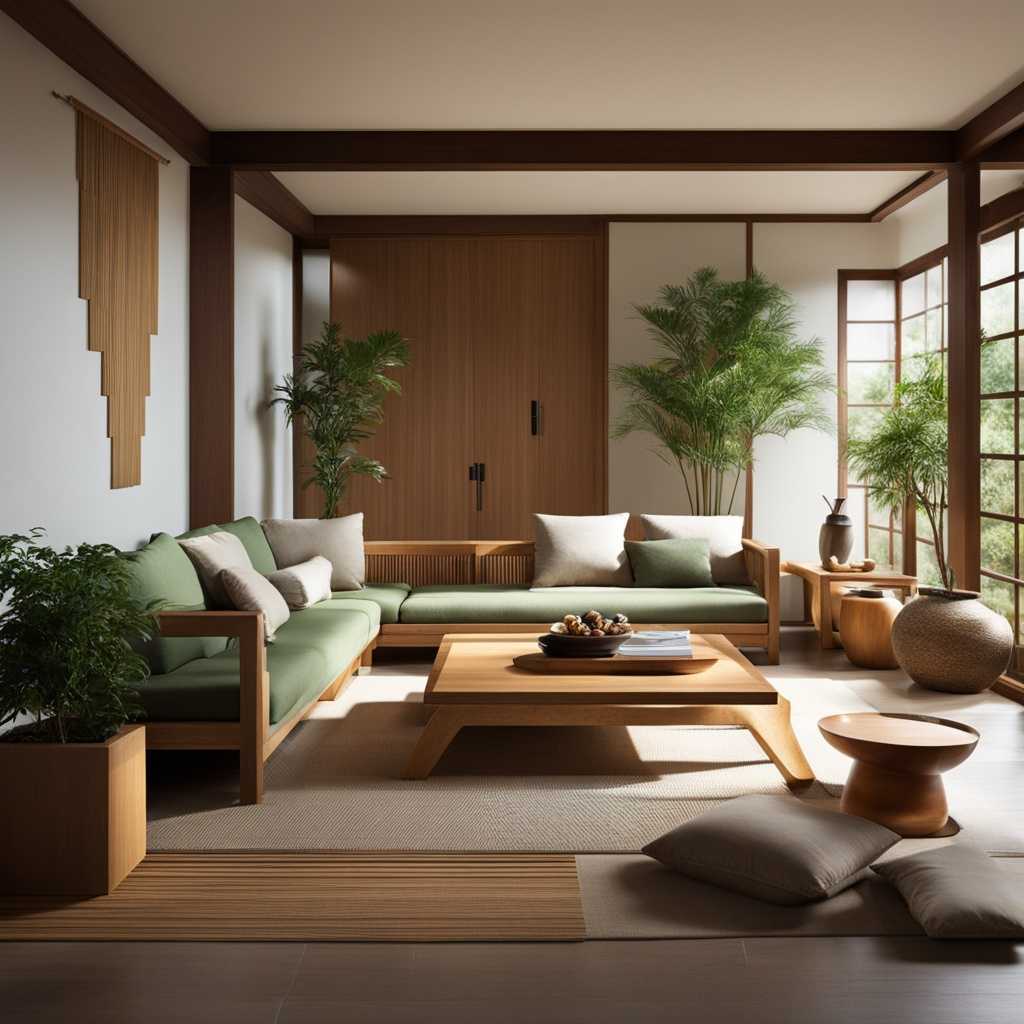
Creating a Zen-inspired living room focuses on key ideas. These ideas make the space calm and welcoming. Important parts include simplicity, a neutral color scheme, and natural materials.
Simplicity and Functionality
Japanese design values simplicity and functionality. By reducing clutter and choosing furniture that serves more than one purpose, the space becomes more useful. This makes the room peaceful, perfect for thinking clearly and relaxing.
Neutral Color Palette
A neutral color palette is key to a calm feel. Soft whites, gentle greys, and earthy tones bring peace and match the design well. This color scheme helps everything in the room stand out, creating harmony.
Natural Materials
Using natural materials is crucial for a Zen look. Wood, stone, and other natural elements connect us to nature. They add character to the room and follow Japanese design’s love for nature’s beauty.
Japanese Living Room Design Ideas
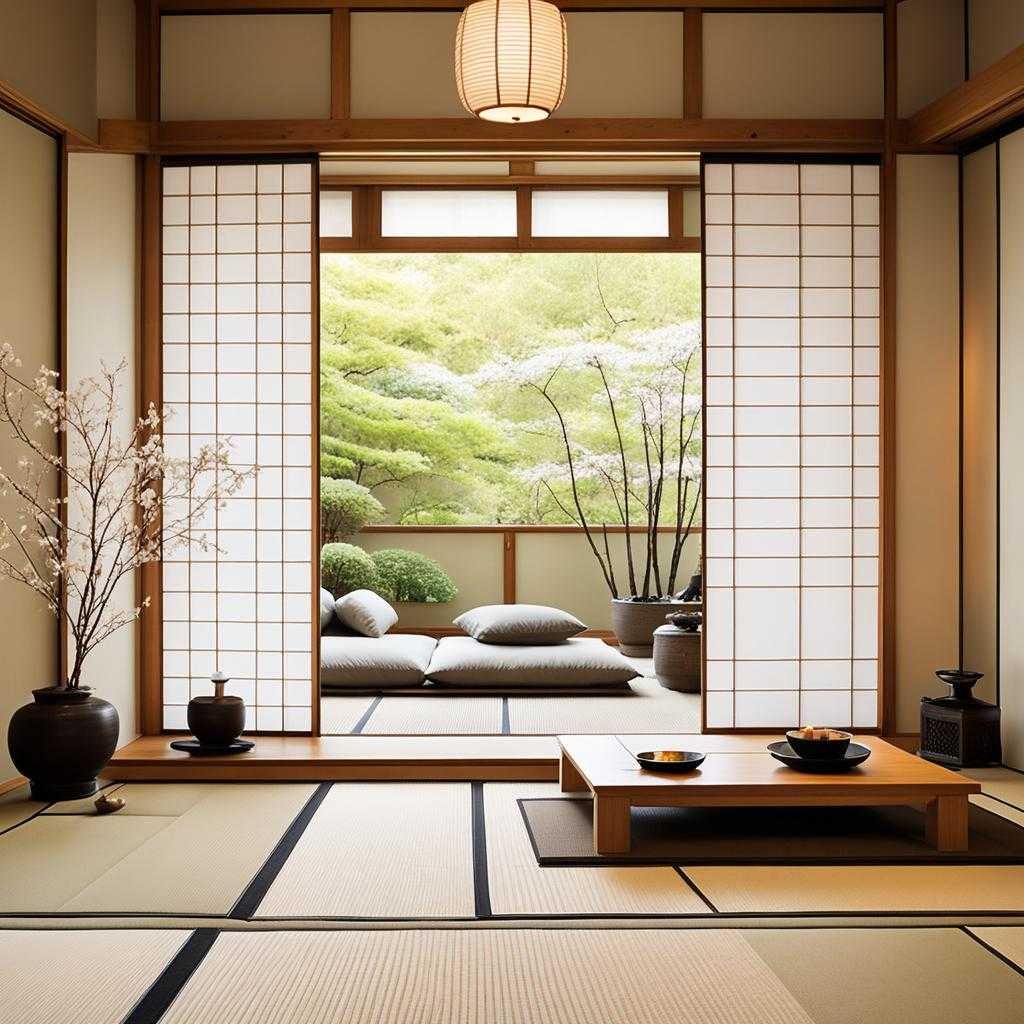
Creating a peaceful living room can be done with specific design elements that reflect Japanese style. Using shoji screens, tatami mats, and low furniture makes the room inviting and true to Japanese culture.
Incorporating Shoji Screens
Shoji screens are both useful and beautiful in a Japanese living room. They offer privacy and let natural light in, making the room feel warm. Their simple design fits well with other elements, creating a sense of openness and defining areas in the room.
Using Tatami Mats for Authentic Style
Tatami mats are key for a real Japanese look. They’re made from rice straw and are both soft and beautiful. Putting tatami mats on the floor makes the room cozy and connects you to Japanese traditions. They also match well with low furniture, making the room look unified.
Low Furniture for a Relaxing Atmosphere
Choosing low furniture in a Japanese living room makes the room feel calm and open. This seating style fits with the traditional Japanese way of life. Low pieces like cushions and tables go well with shoji screens and tatami mats, making the room flow well.
For those wanting to mix modern with tradition, these elements work together beautifully. Check out moody farmhouse kitchens for more ideas. They blend rustic with modern, offering a unique take on interior design that brings peace.
Bringing Nature Indoors
Adding natural elements to your home is key to feeling calm and connected. By bringing nature inside, you can make your space welcoming and relaxing. Using indoor plants, natural light, and features like zen gardens or bonsai trees helps create a peaceful vibe.
Indoor Plants and Natural Light
Indoor plants make the air cleaner and add color to your space. Plants like snake plants, peace lilies, and ferns are not only pretty but also make your home feel calm. Putting them near windows lets in natural light, which is great for plants and brightens the room.
Placing plants thoughtfully can make your space look beautiful and balanced. This adds to the room’s design and makes it more inviting.
Zen Gardens and Bonsai Trees
Zen gardens bring peace with their simple beauty. They often have gravel, stones, and simple plants that help you focus and think deeply. Bonsai trees add to this calm with their unique shapes and careful upkeep.
Both zen gardens and bonsai trees make great centerpieces. They let you enjoy the beauty of nature indoors. This adds a special touch to your home, blending art and nature beautifully.
Creating Serenity with Minimalist Furniture
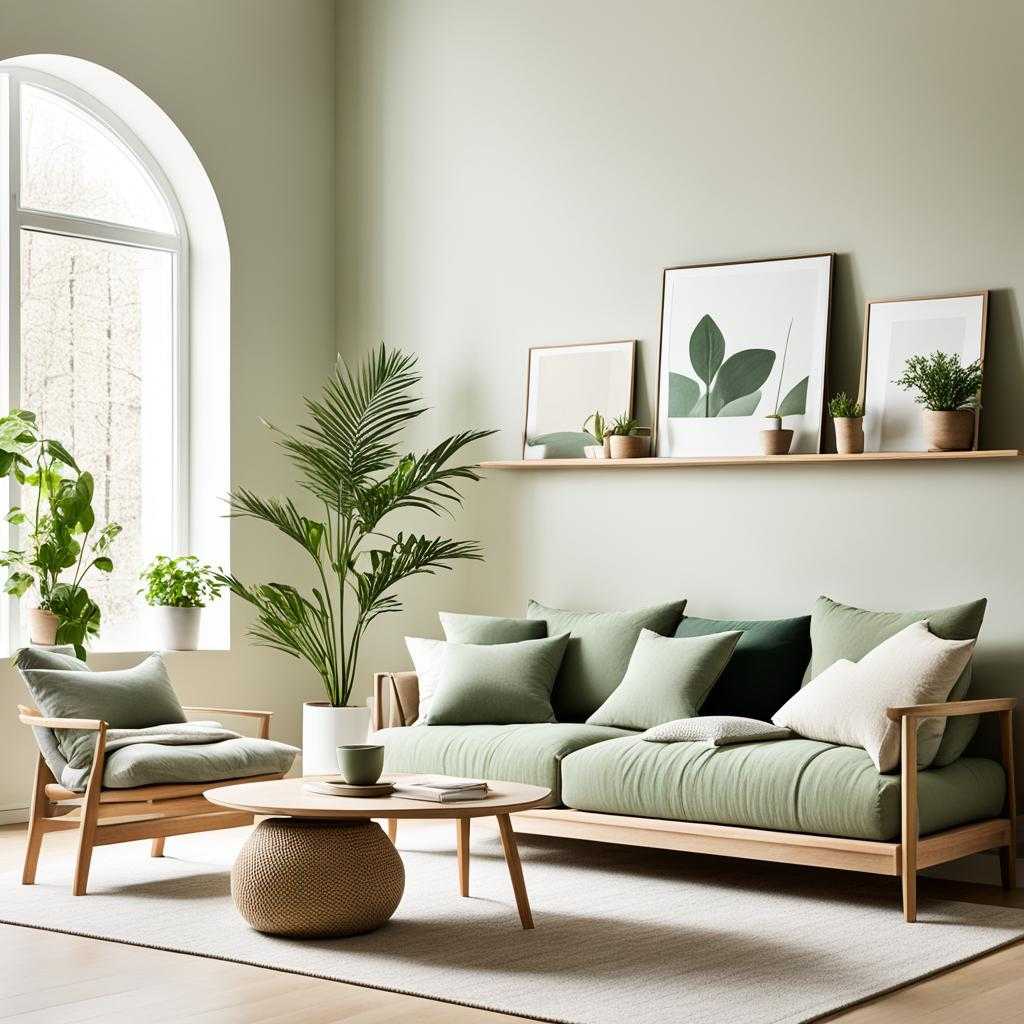
Minimalist furniture is key to a peaceful and tidy Japanese-inspired living room. It focuses on simplicity and function. This makes the room look better and feel calmer. We’ll look at two important parts: the types of furniture and picking the right fabrics.
Types of Low-Profile Furniture
Low-profile furniture adds to comfort and the Zen feeling. Here are some great options:
- Meditation Chairs: These chairs support you while keeping you close to the ground.
- Floor Cushions: Soft and flexible, these cushions fit any seating need.
- Simple Wooden Tables: Uncluttered tables made of natural wood bring warmth and beauty.
- Platform Beds: Low beds make sleeping inviting and save space.
Choosing the Right Fabrics
Picking the right fabrics is key for a calm living space. Choose textures that bring peace and match the minimalist look. Great choices are:
- Natural materials like cotton or linen in soft colors.
- Soft, airy fabrics that make you feel relaxed.
- Simple designs or solid colors for a unified look.
Soft Lighting for a Calming Ambiance
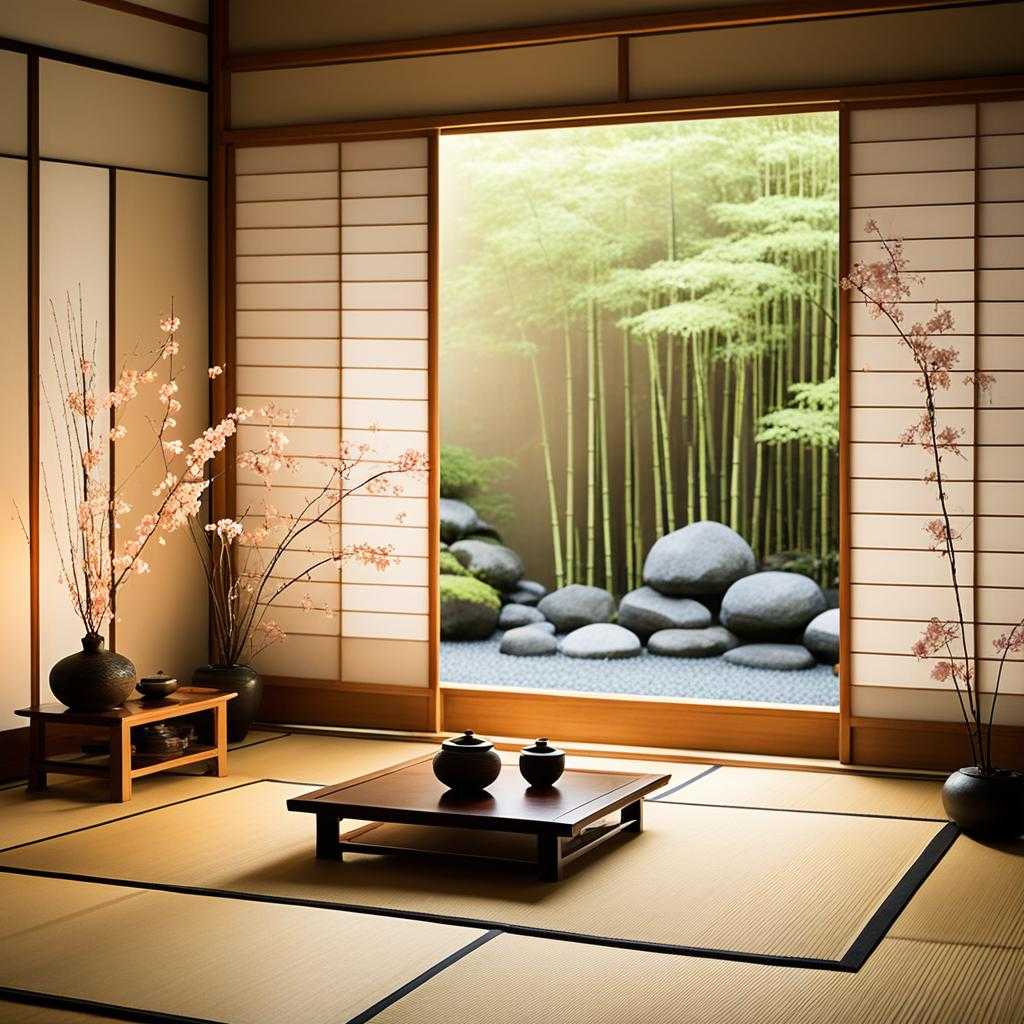
Creating a peaceful living room means picking the right lighting. Soft lighting is key for a calm and inviting feel. It makes the space perfect for relaxing and feeling at ease. Using diffused lighting and decorative lamps and candles adds beauty and peace.
The Importance of Diffused Lighting
Diffused lighting wraps the room in a soft glow. It softens shadows and makes the space feel serene. Unlike harsh lights, diffused lighting blends well with the room, giving a natural look. This type of light is easy on the eyes and helps create a peaceful vibe.
Decorative Lamps and Candles
Adding decorative lamps and candles takes your lighting to the next level. They bring style to your room and let you control the light. Lamps with warm bulbs spread light evenly, and candles add a soft, dancing glow. When placed well, they create a layered lighting effect. This makes your room feel welcoming and calming.
| Lighting Source | Characteristics | Benefits |
|---|---|---|
| Diffused Lighting | Soft, even light | Reduces glare, promotes relaxation |
| Decorative Lamps | Variety of styles, warm glow | Adds aesthetic value, enhances functionality |
| Candles | Natural flickering light | Creates intimate ambiance, soothing effect |
Traditional Japanese Elements to Consider
Adding traditional Japanese elements to your home makes it more beautiful and emotionally touching. These elements bring peace and harmony, making your space perfect for a Zen lifestyle. Features like ikebana flower arrangements and the wabi-sabi aesthetic deepen this connection.
Ikebana Flower Arrangements
Ikebana flower arrangements are more than just decorations. They follow the principles of balance, harmony, and simplicity, which are key in Japanese culture. Ikebana focuses on the beauty of each flower and branch, using minimalism. Unique containers can make the arrangement stand out in any room.
Wabi-Sabi Aesthetic in Decor
The wabi-sabi aesthetic values the beauty of imperfection and change. It suggests using handmade or vintage items in your decor to celebrate individuality. Adding these elements creates a cozy, unique atmosphere. Displaying rustic pottery or letting aged wood show can turn your space into a personal art gallery.
Modern Japanese Influences in Living Rooms
In recent years, modern Japanese influences have become more popular in living room design. The Japandi style is a big part of this trend. It combines the beauty of traditional Japanese design with the simplicity of Scandinavian style. This mix creates a calm and minimalist living space.
Japandi Style: A Fusion of Aesthetics
The Japandi style loves clean lines and practical designs. It uses natural materials like wood and stone to make a peaceful space. This style brings together the best of modern Japanese and Scandinavian design, offering a new way to think about living spaces.
Incorporating Scandinavian Elements
Adding Scandinavian elements to Japanese design makes the space feel more welcoming. Warm colors and soft fabrics make the room cozy. Including plants and natural shapes connects us to nature. By mixing these styles, homeowners can create a space that honors both cultures.
Practical Tips for Designing a Zen Space
Creating a Zen space means thinking carefully about design. Start by decluttering your living area to bring peace and calmness. A clean space helps you relax and be mindful, key to a Zen feel. Once you’ve cleared out what you don’t need, decorate with intention. Choose items that mean something to you, showing simplicity and balance.
Decluttering Your Living Area
Decluttering is key to a Zen space. Begin by looking at each item and asking if it has a purpose or makes you happy. Here are some tips for decluttering:
- Use the one-in, one-out rule; for every new item, let go of an old one.
- Set aside time each week to tackle small areas, making the task manageable.
- Organize your belongings with storage solutions that are functional yet aesthetically pleasing.
Decorate with Intention
After decluttering, focus on decorating with intention. Pick decor that fits your style and the calm mood you want. Consider these tips:
- Select a few statement pieces that convey meaning or beauty.
- Incorporate natural elements, such as wood or stone, to connect with nature.
- Utilize a calming color palette that promotes relaxation.
Conclusion
Using Japanese living room design ideas can turn your space into a peaceful spot. Focus on balance, simplicity, and nature to make a calm environment. This approach helps create a room that’s both beautiful and practical.
Adding plants, natural light, or bonsai trees brings nature inside. This is key to a zen-inspired home. It makes your living area a place for clear thinking and peace, away from daily stress.
To make a serene living room, start with careful thought in your design. By applying Japanese design ideas, you can make a space that’s peaceful and supports a balanced life. Use these tips to make your living area a true zen retreat.




